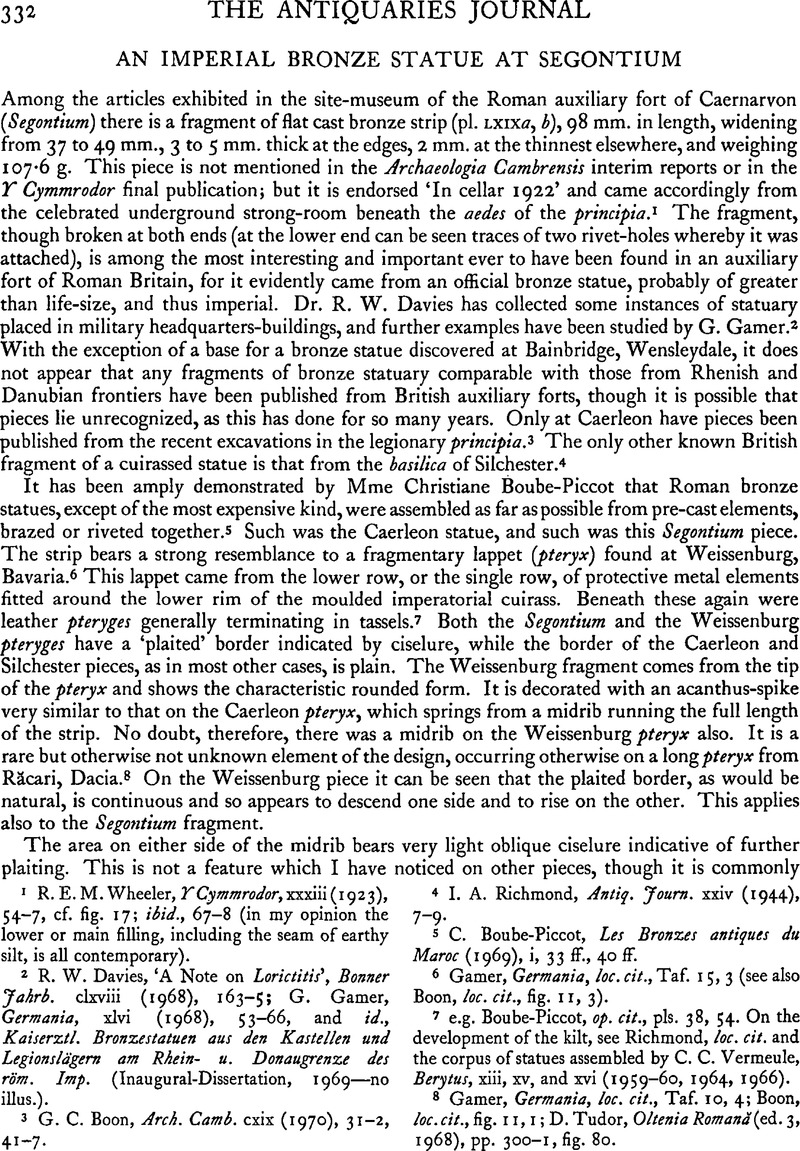Published online by Cambridge University Press: 29 November 2011

page 332 note 1 Wheeler, R.E.M., Y Cymmrodor, xxxiii (1923), 54–7Google Scholar, cf. fig. 17; ibid., 67–8 (in my opinion the lower or main filling, including the seam of earthy silt, is all contemporary).
page 332 note 2 Davies, R. W., ‘A Note on Lorictitis’, Bonner Jahrb. clxviii (1968), 163–5Google Scholar; Gamer, G., Germania, xlvi (1968), 53–66Google Scholar, and id., Kaiserztl. Bronzestatuen aus den Kastellen und Legionslägern am Rhein- u. Donaugrenze des röm. Imp. (Inaugural-Dissertation, 1969—no illus.).
page 332 note 3 Boon, G. C., Arch. Camb. cxix (1970), 31–2, 41–7.Google Scholar
page 332 note 4 Richmond, I. A., Antiq. Journ. xxiv (1944), 7–9Google Scholar
page 332 note 5 Boube-Piccot, C., Les Bronzes antiques du Maroc (1969), i, 33 ff., 40 ff.Google Scholar
page 332 note 6 Gamer, Germania, loc. cit., Taf. 15, 3 (see also Boon, loc. cit., fig. 11, 3).
page 332 note 7 e.g. Boube-Piccot, op. cit., pls. 38, 54. On the development of the kilt, see Richmond, loc. cit. and the corpus of statues assembled by Vermeule, C. C., Berytus, xiii, xv, and xvi (1959–1960, 1964, 1966).Google Scholar
page 332 note 8 Gamer, Germania, loc. cit., Taf. 10, 4; Boon, loc. cit., fig. 11, 1; Tudor, D., oltenia Romană (ed. 3, 1968), pp. 300–1, fig. 80.Google Scholar
page 333 note 1 e.g. Boube-Piccot, op. cit., pls. 41, 44.
page 333 note 2 Wheeler, loc. cit., pp. 54–6 (I believe the cement rendering was original and not a secondary covering).
page 333 note 3 Tudor, op. cit., p. 301.
page 333 note 4 Boon, loc. cit., pp. 31–2.
page 333 note 5 R.I.B., i, no. 429. The other material, Wheeler, loc. cit., pp. 68, 80.
page 333 note 6 These are not likely to have been coined after c. 340 when a different type was issued from the mints. Indeed Constantinopolis probably ceased to be issued in 335; but was counterfeited in the period c. 337–40 in Somerset (White Woman's Hole).